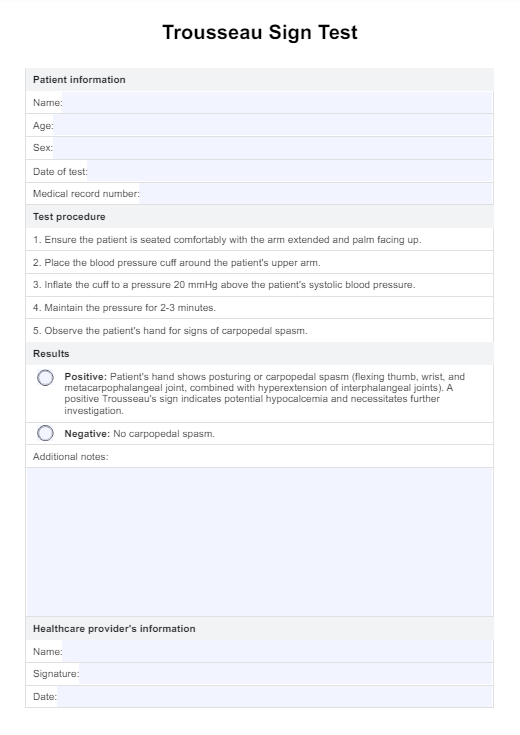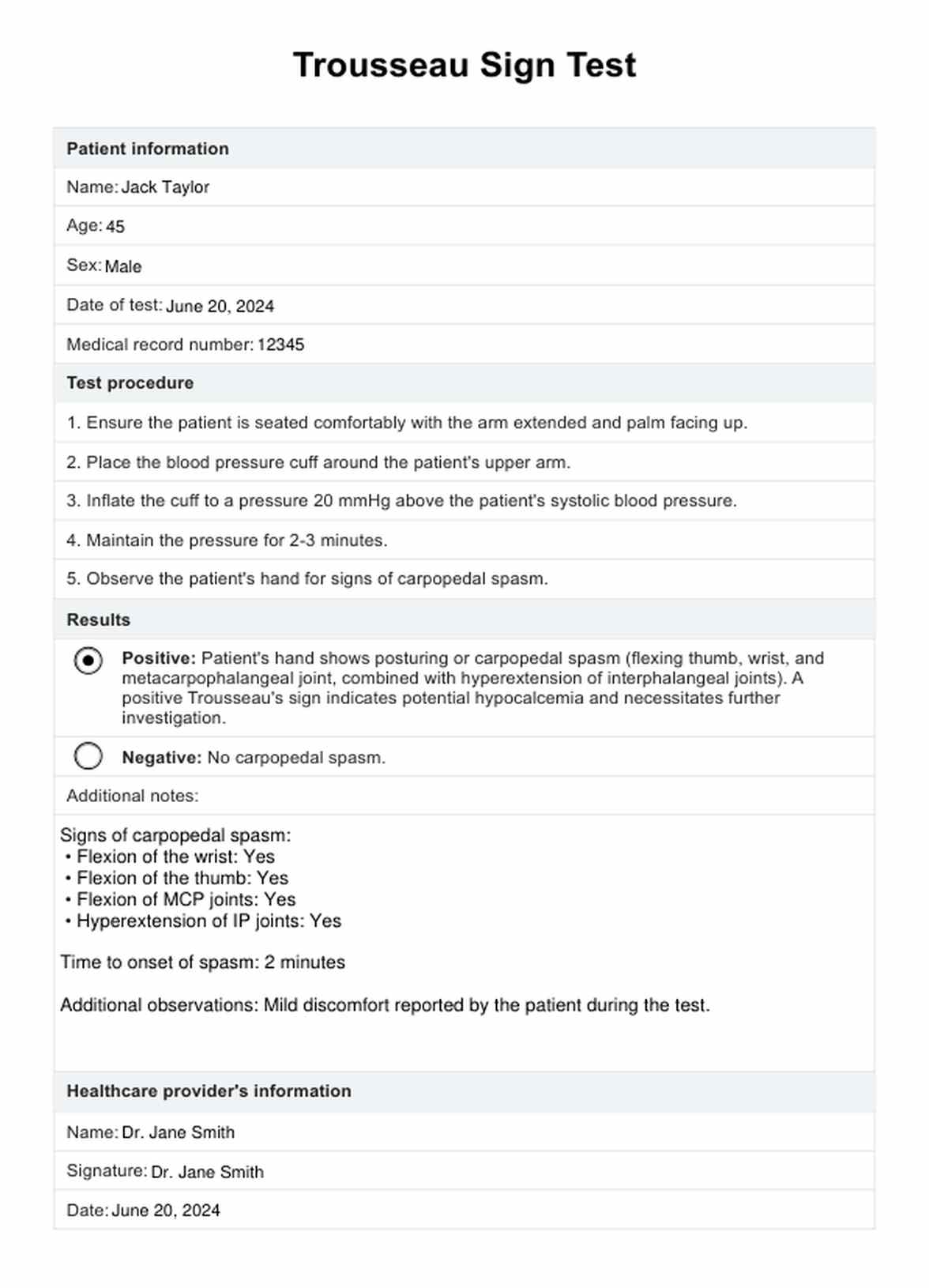Trousseau Sign Test
Learn about the Trousseau Sign Test, its importance in medical diagnosis, and download Carepatron's free PDF template to understand its application better.


What is hypocalcemia?
Hypocalcemia, a common condition in clinical medicine, refers to lower-than-normal levels of calcium in the bloodstream. Calcium plays a crucial role in various physiological functions, including muscle contraction, nerve transmission, hormone secretion, and bone health. In internal medicine, hypocalcemia is typically diagnosed through blood tests that measure calcium levels.
Furthermore, individuals with hypocalcemia are at increased risk of blood clots and abnormal heart rhythms due to the role of calcium in blood clotting and cardiac muscle contraction. Therefore, monitoring vital signs, including blood pressure and heart rate, is essential in managing and treating hypocalcemia to prevent complications.
Symptoms of hypocalcemia
Hypocalcemia presents with a range of symptoms that can vary in severity depending on the degree of calcium deficiency in the bloodstream. Recognizing these symptoms is crucial for timely diagnosis and treatment. Common signs and symptoms include:
- Muscle cramps and spasms: Particularly in the hands and feet.
- Tingling or numbness: Especially around the mouth or in the hands and feet (latent tetany).
- Seizures or convulsions: Due to increased neuromuscular irritability.
- Changes in mental status: Such as confusion or memory impairment.
- Difficulty swallowing: Due to muscle spasms in the throat.
- Abnormal heart rhythms: Resulting from impaired calcium regulation in cardiac muscle.
- Bone pain and osteoporosis: Calcium deficiency affects bone health and density.
These symptoms may develop gradually or suddenly depending on the underlying cause of hypocalcemia, which can include dietary deficiencies, certain medications, thyroid disorders, or kidney disease.
Causes of hypocalcemia
Hypocalcemia can arise from various underlying conditions that disrupt the balance of calcium in the body. One common cause is inadequate dietary intake of calcium and vitamin D, essential for calcium absorption in the intestines.
Other causes include medical conditions such as chronic kidney disease, where impaired kidney function hinders calcium regulation and excretion.
Additionally, disorders affecting the parathyroid glands, which regulate calcium levels through parathyroid hormone (PTH), can lead to hypocalcemia. These conditions include hypoparathyroidism, characterized by insufficient PTH production, or surgical removal or damage to the parathyroid glands.
Trousseau Sign Test Template
Trousseau Sign Test Example
What is the Trousseau Sign Test?
The Trousseau Sign test, a notable assessment in clinical medicine, serves as a diagnostic tool for detecting latent tetany, a symptom of hypocalcemia. Named after French physician Armand Trousseau, this test involves inflating a sphygmomanometer cuff (typically used for measuring blood pressure) around the patient's arm to a pressure above systolic blood pressure for several minutes. During this time, a positive Trousseau's sign manifests as carpal spasm—flexion of the wrist and metacarpophalangeal joints, with extension of the interphalangeal joints—indicating neuromuscular irritability due to calcium deficiency.
Healthcare professionals use the Trousseau Sign Test alongside other assessments, such as Chvostek's sign, to aid in diagnosing hypocalcemia. The Chvostek sign test involves tapping the facial nerve anterior to the ear, eliciting facial twitching if the patient is hypocalcemic.
If positive Chvostek's and Trousseau's signs are observed, further evaluation, including blood tests measuring calcium levels, is typically pursued. Treatment for hypocalcemia often involves calcium supplementation, such as calcium gluconate, to correct the deficiency and alleviate symptoms associated with calcium imbalance.
How is this test conducted?
The Trousseau's sign test is conducted following specific steps to elicit a positive response indicating neuromuscular irritability due to calcium deficiency. Here’s how the test is performed:
- Prepare the patient: Position the patient comfortably, typically seated, with their arm extended and palm facing upward.
- Apply the cuff: Place the sphygmomanometer cuff around the upper arm as you would for measuring blood pressure, ensuring a snug fit.
- Inflate the cuff: Inflate the cuff gradually, aiming to reach a pressure approximately 20 mmHg above the patient's systolic blood pressure.
- Observe for spasm: Maintain this pressure for 2 to 3 minutes while observing the patient's hand for any involuntary muscle contractions or spasms.
- Document findings: Note any positive Trousseau's sign, characterized by flexion of the wrist and metacarpophalangeal joints with extension of the interphalangeal joints.
How are the results interpreted?
A positive Trousseau's sign is identified by the appearance of a carpopedal spasm, characterized by flexion of the wrist, thumb, and metacarpophalangeal (MCP) joints, accompanied by hyperextension of the interphalangeal (IP) joints. This involuntary muscle contraction occurs due to ischemia induced by the inflated cuff, which triggers neuromuscular irritability in individuals with calcium deficiency.
It's important to note that a positive Trousseau's sign is not commonly found in healthy individuals, with less than 4 percent showing this response under normal circumstances. Therefore, when observed during the test, healthcare professionals consider it a significant clinical indicator of hypocalcemia.
The presence of this sign prompts further investigation, including laboratory tests to measure serum calcium levels, to confirm the diagnosis and initiate appropriate treatment strategies such as calcium supplementation.
Next steps after conducting this test
After conducting the Trousseau's sign test and identifying a positive response indicative of neuromuscular irritability possibly due to hypocalcemia, healthcare providers typically proceed with further diagnostic measures. This includes ordering laboratory tests to measure serum calcium levels and assessing other electrolyte levels to confirm the diagnosis. Additionally, a thorough clinical evaluation is conducted to determine the underlying cause of the calcium deficiency.
Once hypocalcemia is confirmed, treatment strategies are initiated, which may include calcium supplementation and addressing the underlying condition if present. Monitoring of symptoms and periodic reassessment of calcium levels are essential to ensure effective management and prevention of complications associated with calcium imbalance.
How to use our Trousseau Sign Test template
Carepatron's Trousseau Sign Test template is designed to assist medical professionals in efficiently documenting and interpreting the Trousseau's sign test. Below are the steps to effectively use this template:
Step 1: Access and download template
First, access the Carepatron platform and find the Trousseau Sign Test template in the Resource Library. Download the template for you to use during the assessment.
Step 2: Patient information
Begin by filling out the patient's information, including their name, age, and medical history. Accurate documentation of patient details is crucial for proper record-keeping and follow-up.
Step 3: Conduct the Trousseau Sign Test
Perform the Trousseau sign test by placing a sphygmomanometer cuff around the patient’s upper arm. Inflate the cuff to a pressure 20 mmHg above the patient’s systolic blood pressure and maintain it for 2 to 3 minutes. Observe the patient's hand for signs of carpopedal spasm.
Step 4: Record the results
Using the template, document the presence or absence of a positive Trousseau's sign. Note any carpopedal spasm, including the flexion of the wrist, thumb, MCP joints, and hyperextension of the IP joints.
Step 5: Interpretation and next steps
After recording the test results, use the template to guide the interpretation of findings. If a positive Chvostek's and Trousseau’s sign are observed, proceed with further diagnostic tests to confirm hypocalcemia and identify underlying causes. Document the next steps, including additional tests and treatment plans, within the template.
Common treatments for hypocalcemia
Hypocalcemia is typically managed by addressing the underlying cause and restoring normal calcium levels. The primary treatment involves calcium supplementation, often administered orally in mild cases or intravenously in severe cases to quickly elevate serum calcium levels. Vitamin D supplementation is also crucial as it enhances calcium absorption in the intestines.
In cases where hypocalcemia is due to hypoparathyroidism, synthetic parathyroid hormone may be prescribed to help regulate calcium levels. Dietary modifications, including increasing intake of calcium-rich foods such as dairy products, leafy greens, and fortified foods, are often recommended.
Additionally, magnesium supplementation may be necessary, as magnesium deficiency can impair calcium regulation. Regular monitoring of blood calcium levels and adjusting treatment plans as needed is essential to ensure that patients maintain calcium levels within the normal range. By combining these approaches, healthcare providers can effectively manage hypocalcemia and prevent its associated complications.
Commonly asked questions
Trousseau's sign is a clinical indicator of latent tetany where carpal spasm occurs due to ischemia induced by a blood pressure cuff. Chvostek's sign involves facial muscle twitching in response to tapping the facial nerve, both indicating potential hypocalcemia.
A positive Trousseau's sign means there is neuromuscular irritability due to low calcium levels in the blood. This suggests the presence of hypocalcemia, necessitating further evaluation and treatment.
A positive Trousseau's sign is caused by hypocalcemia, an electrolyte imbalance characterized by low levels of calcium in the blood.







































































































